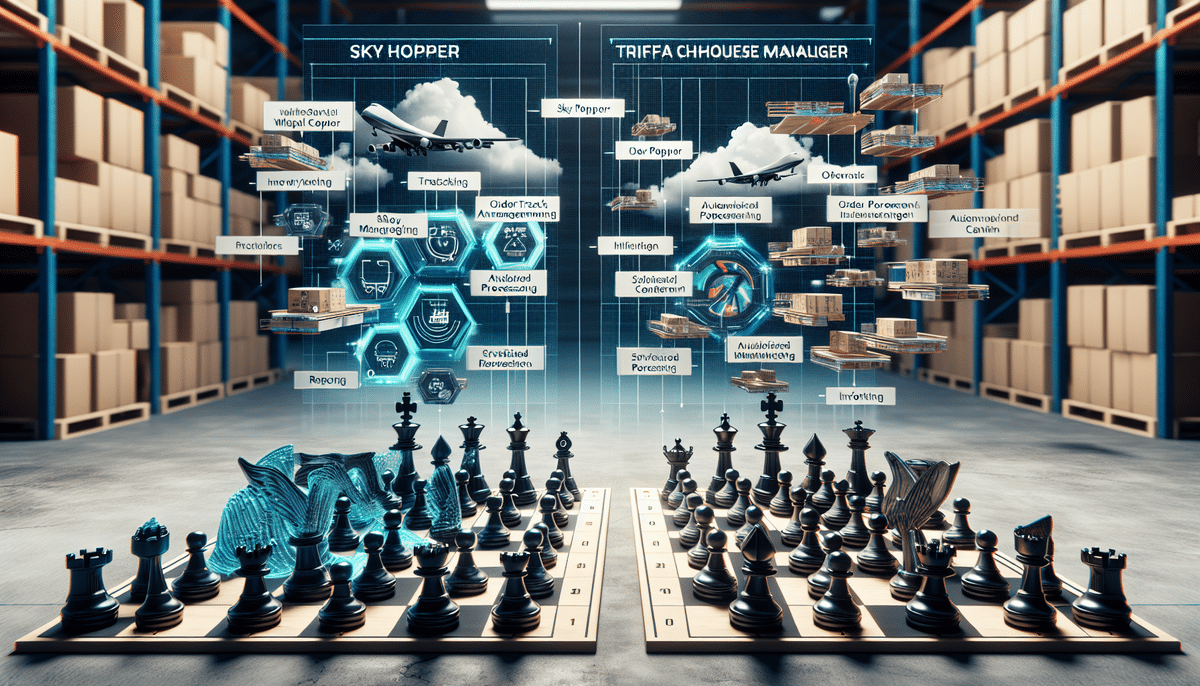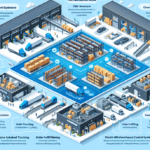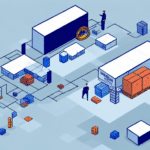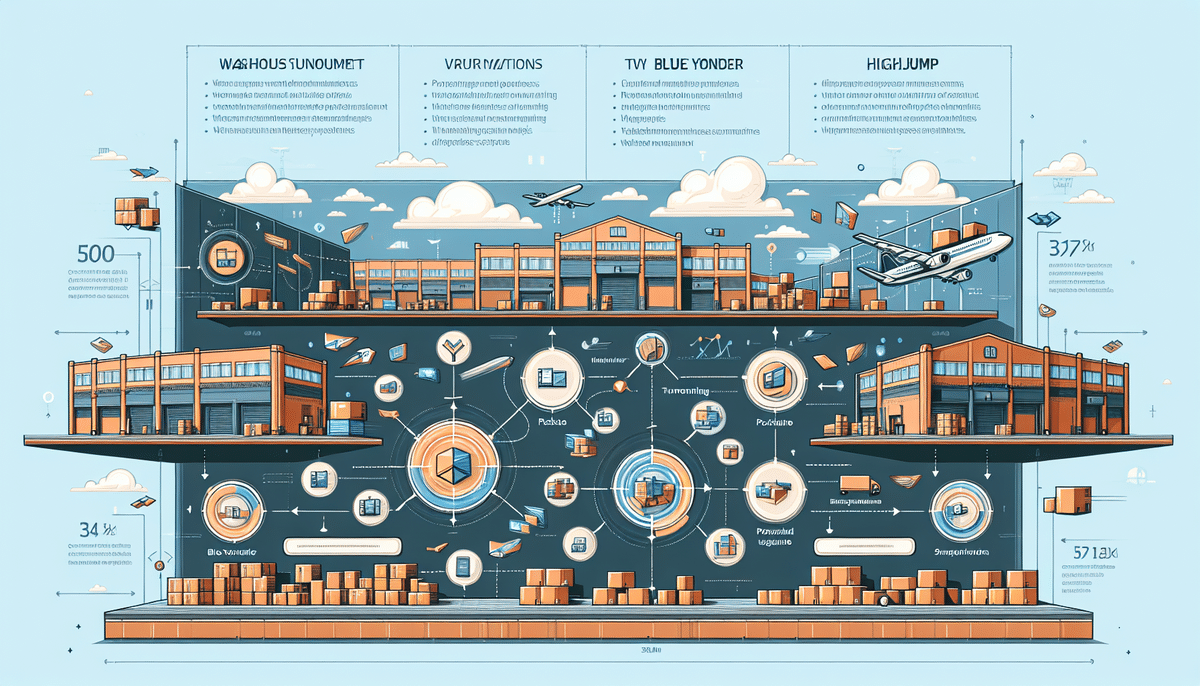Blue Yonder (formerly JDA Software) WMS vs 3PL Central (3PL Warehouse Manager)
Warehouse management systems (WMS) are essential for businesses of all sizes that handle a significant volume of products. These systems streamline processes such as inventory tracking, order processing, and shipping, enhancing efficiency and accuracy. Two leading solutions in this space are Blue Yonder's WMS and 3PL Central's 3PL Warehouse Manager. This comparison explores their features, benefits, and suitability for different business needs.
Why Warehouse Management Systems Matter
A warehouse management system (WMS) is crucial for many businesses to maintain accurate inventory levels and manage the ordering process effectively. Without a WMS, companies may face stock shortages or overstocking, leading to inefficiencies and increased costs. Additionally, a WMS optimizes warehouse operations by streamlining picking, packing, and shipping processes, ensuring timely and accurate order fulfillment.
Real-time data provided by a WMS empowers businesses to make informed decisions about restocking and order fulfillment, thereby improving customer satisfaction and boosting sales. Automation features like barcode scanning and order tracking reduce errors and enhance operational accuracy.
In the long term, implementing a WMS can lead to significant cost savings by optimizing labor costs, minimizing the risk of lost or damaged inventory, and identifying areas for process improvement to increase overall efficiency and profitability.
For a comprehensive overview of the benefits of a WMS, refer to Investopedia's WMS Guide.
Understanding Blue Yonder's WMS
Blue Yonder, formerly known as JDA Software, offers a robust Warehouse Management System designed to enhance efficiency and productivity while reducing operational costs. Key features include real-time inventory tracking, automated order processing, and advanced reporting capabilities.
Integration Capabilities
Blue Yonder's WMS seamlessly integrates with other supply chain management solutions such as transportation management systems (TMS) and demand planning software. This integration provides comprehensive visibility and control over inventory and order fulfillment across the entire supply chain.
Customization and Scalability
The system is highly customizable, allowing businesses to tailor workflows to their specific needs. Flexible pricing options, including pay-per-use and subscription models, make it adaptable for businesses of varying sizes and budgets.
For more details, visit Blue Yonder's official WMS page.
Understanding 3PL Central's 3PL Warehouse Manager
3PL Central provides a cloud-based 3PL Warehouse Manager tailored specifically for third-party logistics (3PL) providers. This system includes features like inventory tracking, order processing, billing, and invoicing, all designed to enhance the efficiency of 3PL operations.
System Integration
3PL Central's WMS integrates effortlessly with clients' systems, facilitating seamless communication and data sharing. This ensures real-time visibility into inventory levels and order statuses, enabling 3PL providers to make informed decisions and improve operational efficiency.
Customizable Reporting
The platform offers customizable reporting capabilities, allowing users to generate reports that meet their specific requirements. This feature is particularly beneficial for 3PL providers who need to provide detailed analytics to their clients.
Learn more at 3PL Central's official website.
Key Features of Blue Yonder's WMS
- Real-time inventory tracking and management
- Automated order processing
- Advanced reporting and analytics
- Integration with other supply chain tools like TMS
- Support for multiple warehouse locations
- Mobile functionality for warehouse staff
Additional Features
- Customizable workflows to align with business processes
- Flexible pricing models, including subscription and pay-per-use
Blue Yonder's WMS allows businesses to tailor the system to their unique workflows, ensuring seamless integration with existing processes. The flexible pricing options provide cost-effective solutions for businesses of all sizes.
For an in-depth look at Blue Yonder's WMS features, visit the features page.
Key Features of 3PL Central's 3PL Warehouse Manager
- Cloud-based platform for enhanced flexibility and scalability
- Comprehensive inventory tracking and management
- Efficient order processing and fulfillment
- Accurate billing and invoicing functionality
- Support for barcode scanning
- Integration with other supply chain tools like TMS and e-commerce platforms
3PL Central's Warehouse Manager is designed to meet the specific needs of 3PL providers, offering robust features that facilitate efficient warehouse operations and seamless integration with client systems.
Explore more features on the 3PL Central features page.
Strengths and Weaknesses of Blue Yonder's WMS
Strengths
- Comprehensive feature set covering all aspects of warehouse management
- Strong integration capabilities with other supply chain solutions
- Highly customizable to fit specific business needs
- Established reputation and long-standing presence in the supply chain industry
Weaknesses
- Higher cost compared to some competitors, potentially limiting accessibility for smaller businesses
- Reports of challenges with software updates and integrations
While Blue Yonder's WMS offers extensive features and integration capabilities, its cost may be a barrier for smaller businesses. Additionally, some users have experienced difficulties with updates and system integrations.
For user reviews and more insights, visit G2 Reviews.
Strengths and Weaknesses of 3PL Central's 3PL Warehouse Manager
Strengths
- Designed specifically for 3PL providers, addressing their unique needs
- Cloud-based platform offers high flexibility and scalability
- User-friendly interface with real-time inventory tracking
- Customizable reporting for detailed analytics
Weaknesses
- May lack some advanced features found in more comprehensive WMS solutions
- Users have reported slow response times and challenges with system customization
- Not ideally suited for businesses outside the 3PL provider category
3PL Central's Warehouse Manager excels in catering to 3PL providers with its specialized features and cloud-based flexibility. However, it may not offer the same depth of features as other WMS solutions and may present customization challenges.
Check out G2 Reviews for more user feedback.
Which is More Cost-Effective: Blue Yonder's WMS or 3PL Central's 3PL Warehouse Manager?
When evaluating the cost-effectiveness of a WMS, it's essential to consider the total cost of ownership, which includes implementation, training, and ongoing support. Blue Yonder's WMS tends to be more expensive, reflecting its comprehensive feature set and integration capabilities, making it suitable for larger enterprises with more complex needs.
On the other hand, 3PL Central's Warehouse Manager offers a more affordable solution tailored specifically for 3PL providers. Its cloud-based model can provide cost savings in terms of infrastructure and scalability, making it a better fit for small to medium-sized 3PL businesses.
Businesses should assess their specific requirements, budget constraints, and the anticipated return on investment (ROI) when choosing between these two systems.
For a detailed cost comparison, consulting with each provider or using third-party comparison tools can provide more personalized insights.
Customer Reviews and Satisfaction Ratings for Blue Yonder's WMS and 3PL Central's 3PL Warehouse Manager
Customer feedback is a valuable indicator of a WMS's effectiveness and user satisfaction. Both Blue Yonder and 3PL Central have garnered positive reviews from their user bases.
Blue Yonder's WMS
According to G2, Blue Yonder's WMS holds a 4.0 out of 5-star rating based on user reviews. Users commend its robust feature set and real-time inventory visibility. However, some reviews highlight challenges with implementation and system integrations.
3PL Central's 3PL Warehouse Manager
3PL Central's Warehouse Manager boasts a 4.3 out of 5-star rating on G2. Users appreciate its user-friendly interface and effective inventory tracking across multiple locations. Some feedback points to slow response times and difficulties with customization.
These ratings suggest that while both systems are well-regarded, the choice may depend on specific business needs and priorities.
Integrating a Warehouse Management System with Your Business
Successful integration of a WMS with existing business tools and systems is crucial for seamless operations. A well-integrated WMS should connect effortlessly with other supply chain management tools, such as transportation management systems (TMS) and e-commerce platforms, ensuring a smooth flow of data across the supply chain.
Considerations for Integration
- Compatibility: Ensure the WMS is compatible with your current software and hardware infrastructure.
- Data Migration: Plan for efficient data migration to avoid disruptions during the transition.
- Customization: The WMS should allow for customization to meet specific integration requirements.
- Support and Training: Partner with knowledgeable consultants or the software vendor to facilitate a smooth integration process.
Working with experienced partners and thoroughly planning the integration process can mitigate potential challenges and ensure that the WMS enhances overall business operations.
For best practices in WMS integration, refer to articles like Supply Chain Digital's WMS Implementation Tips.
Choosing the Right Warehouse Management System for Your Business
Selecting the appropriate WMS depends on several factors unique to each business. Key considerations include:
- Business Size and Complexity: Larger enterprises with complex operations may benefit from a comprehensive WMS like Blue Yonder's, while smaller businesses might find 3PL Central's solution more aligned with their needs.
- Budget Constraints: Assessing the total cost of ownership, including upfront and ongoing costs, is essential to ensure financial feasibility.
- Feature Requirements: Identify the critical features needed for your operations, such as real-time tracking, reporting capabilities, and integration with other systems.
- Scalability: Choose a WMS that can scale with your business growth and adapt to changing operational demands.
- Vendor Support: Reliable customer support and training resources are vital for successful implementation and long-term use.
Conducting a thorough needs assessment and evaluating potential WMS solutions against these criteria will help businesses make informed decisions that align with their operational goals and budgetary constraints.
Comparing Other Popular Warehouse Management Systems with Blue Yonder and 3PL Central
In addition to Blue Yonder and 3PL Central, several other WMS options are popular in the market. These include:
- Microsoft Dynamics 365 for Finance and Operations: Offers integrated WMS capabilities within its broader ERP solutions.
- SAP Extended Warehouse Management: Known for its scalability and integration with other SAP modules.
- Infor Supply Chain Management: Provides comprehensive WMS features with a focus on usability and integration.
- Oracle Warehouse Management: Offers robust features suitable for large enterprises with complex supply chain needs.
The suitability of these systems varies based on specific business requirements, budget, and existing technology stack. A detailed comparison of features, pricing, and user reviews is recommended to identify the best fit for your organization.
For more comparisons, refer to Software Advice's WMS Comparison Guides.
Case Studies: How Businesses Have Benefited from Using Blue Yonder and/or 3PL Central
Real-world case studies demonstrate the tangible benefits of implementing a WMS. Here are some examples:
- Global Automotive Supplier: Leveraged Blue Yonder's WMS to achieve a 60% increase in replenishment efficiency, resulting in reduced operational costs and enhanced order accuracy and customer service.
- Nutritional Supplement Company: Utilized 3PL Central's Warehouse Manager to eliminate the need for standalone systems, digitize their warehouse management processes, and increase order accuracy by 99.5%.
These case studies highlight how businesses across different industries can tailor WMS solutions to meet their specific operational challenges and achieve significant improvements in efficiency and accuracy.
For more detailed case studies, visit the Blue Yonder Case Studies and 3PL Central Case Studies pages.
Future Developments in Warehouse Management Technology and How They May Impact Your Choice of System
Warehouse management technology is continuously evolving, with several trends shaping the future of WMS solutions:
- Automation and Robotics: Increased use of automated systems and robotics to handle repetitive tasks, enhancing efficiency and reducing labor costs.
- Artificial Intelligence and Machine Learning: Implementing AI and ML to optimize warehouse operations, forecast demand, and improve decision-making processes.
- Internet of Things (IoT): Integrating IoT devices for real-time tracking and monitoring of inventory, equipment, and environmental conditions within the warehouse.
- Cloud Computing: Greater adoption of cloud-based WMS solutions for improved scalability, accessibility, and cost-effectiveness.
- Enhanced Data Analytics: Leveraging advanced analytics to gain deeper insights into warehouse operations and drive continuous improvement.
Businesses should consider how these emerging technologies align with their operational goals and choose a WMS that is adaptable to incorporate these advancements, ensuring long-term relevance and competitiveness.
Stay updated with the latest trends by following resources like Supply Chain Digital and Supply Chain Management Review.
Conclusion
Warehouse management systems like Blue Yonder's WMS and 3PL Central's 3PL Warehouse Manager offer comprehensive solutions to help businesses manage their warehouse operations more effectively. Both systems provide a range of features aimed at increasing efficiency, reducing costs, and enhancing accuracy in processes like inventory tracking and order fulfillment.
When choosing between these systems, businesses should evaluate their specific needs, budgetary constraints, and the level of support required. Consider factors such as ease of integration, scalability, customization options, and user feedback to make an informed decision that aligns with your operational goals and drives long-term success.
For further assistance in selecting the right WMS, consulting with industry experts or leveraging comparison tools can provide valuable insights tailored to your unique business requirements.




















